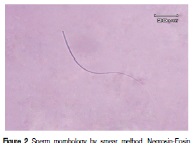Effect of Momordica charantia Linn. leaf and fruit juice on fertility in male mice
Keywords:
Momordica charantia Linn., fertility, prolactin, testosteroneAbstract
Fertility effect of Momordica charantia Linn. leaf and fruit juice at doses of 200, 400 and 600 mg/ 100 gBW were evaluated by determining blood prolactin (PRL) and testosterone (T) levels, and sperm quality in male mice after 21 days of oral administration. The increase in PRL and decrease in T levels were found to be dose dependent in both treatments. Meanwhile, the sperm quality impairment was found in group receiving fruit juice was more severe than that of groups receiving leaf juice. Interestingly, the potency of testicular dysfunction was related to the degree of alteration of reproductive hormones. In conclusion, M. charantia leaf and fruit juice may cause testicular dysfunction, which indirectly affects pituitary PRL synthesis and consequently impaired testicular T synthesis. The use of M. charatia products at high dose in traditional medicine should include a caution about this adverse effect, especially in long term treatment.
References
mitinand T & Santisuk T, Cucurbitacea. In: Flora of Thailand. Vol 9, Part 3, 2008, pp:464-465. [2] Grover JK & Yodav SP, Pharmacological actions and potential uses of Momordica
charantia: A review, J Ethnopharmacol, 2004, 93: 123-132.
Paul A & Raychandluri SS, Medicinal uses and molecular identification of two
Momordica charantia varieties, Electronic J Biol, 2010. 6: 43-51. [4] Kumar DS, Sharathnath KV, Yongeswaran P, Haran A, Sudhakar K, Sudha P & Banji D,
A medicinal potency of Momordica charantia, Int J Pharm Sci Rev Res, 2010, 1: 95-100. [5] Michael B, Krawinkle MB & Keding GB, Bitter gourd (Momordica charantia): A dietary
approach to hypoglycemia, Nutrition, 2006, 64: 331-337. [6] Belion N, Gbeassor M, Akpagana K, Hudson J, De Soussa K, Koumaglo K & Arnason
JT, Ethnomedical uses of Momordica charantia (Cucurbitaceae) in Togo and relation to
Its phytochemistry and biological activity, J Ethnopharmacol, 2005, 96 : 49-55. [7] Kohno H, Yasui Y, Suzuki R, Hosokawa M, Miyashita K, Koumaglo K & Arnason JT,
Dietary seed oil in conjugated linoleic acid from bitter melon inhibits zoxymethane
induced rat colon carcinogenesis through elevation of colonic PPAR gamma expression
of lipid composition, Inter J Cancer, 2004, 110: 896-901. [8] Gadang V, Gilbert W, Heltiarchechy N, Horax R, Katwa L & Devareddy L, Dietary bitter
melon seed increases peroxisome proliferator-activated receptor gamma gene expression
in adipose tissue, down regulates the nucleus factor-LB expression, and alleviates the
symptoms associated with metabolic syndrome, J Med food, 2011, 14: 86-90. [9] Stepka W, Wilson KE & Madge GE, Antifertility investigation on Momordica charantia,
Lloydia, 1974, 34: 645-648. [10] Dixit VP, Khanna P & Bhargava SK, Effect of Momordica charantia L. fruit extract on
the testicular function of dog, Planta Med, 1978, 34: 280-286. [11] Naseem MZ, Patil SR, Patil SR, Ravindra & Patil RB, Antispermatogenic and
androgenic activities of Momordica charantia (Karen) in albino rats, J Ethnopharmacol ,
, 61: 9-16. [12] Patil SR & Patil SB, Toxicological studies of Momordica charantia Linn. seed extract in
male mice, Int J Morphol, 2011, 29: 1212-1218. [13] Patil SR., Patil SB & Sadyanarayan ND, Isolation of phytoestrogen from Momordica
charantia seed (bitter melon). Cur Top Nutraceu Res, 2011, 9:61-66. [14] Amah CI, Ebaetre YO, Ikechukwu DF & Adewale OA, Effect of Momordica charantia
on estrus cycle of Sprague –Dawley rats, Pacific J Med Sci, 2011, 8: 38-48 15] Jerald SE, Pandey A, Bigoniya P & Singh S, Antifertility activity of Momordica
charantia descourt pulp and seed hydroalcoholic extract, J Appl Pharm, 2012, 4: 682-696. [16] Uche-Nwachi EO & McEwen C, Teratogenic effect of the water extract of bitter gourd
(Momordica charantia) on the Sprague- Dawley rats, Afr J Trad Comple Alter Med,
, 7: 24-33. [17] Yokoi K, Uthus EO & Nielsen FH, Nickel deficiency diminishes sperm quality and
movement in rats, Biol Trace Elem Res, 2003, 93; 141-154. [18] Sonmez M, Yuce A &Turk G, The protective effect of melatonin and vitamin E on
antioxidant enzyme activities and epidimal sperm characteristics of homocysteine
treated male rats, Reprod Toxicol, 2007, 23:226-231.
Atessahin A, Turk G, Karaham I, Yilmaz S, Ceribast AO & Bulmus O, Lycopene
prevents adriamycin -induced testicular toxicity in rats, Fertil Steril, 2006, 85: 1216-
. [20] Zar JH, Biostatistical analysis: 5th edition, Pearson Prentice Hall, Inc, New Jercy, USA, 2
,189-248. [21] MaCallum RW, Sowers JR, Hershman JM & Sturdevant RA, Metoclopramide stimulates
prolactin secretion in man, J Clin Endocrinol Metab, 1976, 42: 1148-1151. [22] Freeman MF, Kanyicaka B, Lerant R & Naggy G, Prolactin: structure, function and
regulation of secretion, Physiol Rev, 2000, 80: 1523-1585. [23] Luboshitzky R., Rosen E, Trestian S & Spitz IM, Hyperprolactinemia and
hypogonadism in men: response to exogenous gonadotropins, Clin Endocrinol, 1979, 11:
-223. [24] Murray FT, Cameron DF & Ketchum C, Return of gonadal function in men with
prolactin-secreting pituitary tumors, J Endocrinol Metab, 1984, 59: 79-85. [25] Segal S, Yaffe H, Laufer N & Ben-David M, Male hyperprolactinemia effects on
fertility, Fertil Steril, 1979, 32: 556-561. [26] Winter JJ.& Troen P, Altered pulsatile secretion of luteinizing hormone in hypogonadal
men with hyperprolactinemia, Clin Endocrinol, 2008, 21: 257-263. [27] Chandra AK, Sengupta P, Goswami H & Sarkar M, Excessive dietary calcium in the
disruption of structural and functional status of adult male reproductive system in rat
with possible mechanism. Mol Cell Bioch, 2012, 364: 181-191. [28 ] Sorensen AMJ, Animal reproduction principle and practices, 1979, Graw-Hill, USA. [29] Craft J, Bennet V & Nicholson N, Fertilising ability of testicular spermatozoa, Lancet,
, 342: 864-869.



